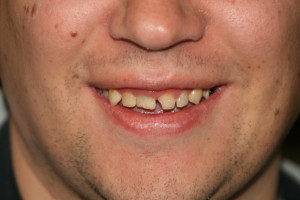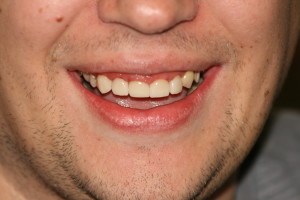Big cavities often require big fillings. In cases where the filling gets very large, broken down, or if the tooth breaks, a filling just isn’t enough. In those instances, a crown (cap) is often the treatment of choice. If several teeth are missing, a bridge may be necessary.
Crowns
Crowns are synthetic caps, usually made of a material like porcelain, placed on the top of a tooth.They may be used to attach bridges, cover implants, prevent a cracked tooth from becoming worse.
Crowns usually require two or more appointments to complete. In the first appointment, after the tooth is numbed, the dentist prepares the tooth by shaving down all surfaces of the tooth to make room for the cap. Next, an impression (mold) is taken of the teeth, which is then sent off to a dental laboratory that makes the crown custom-fit to the tooth. Because the crown fabrication is so precise, it can take a week or more at the laboratory before the crown is done!
While waiting for the real crown to come back from the lab, a temporary crown will be placed on the tooth to help protect it from moving or breaking down. At the second appointment, the temporary crown is removed and the real crown is tried in the mouth. The dentist will check several areas, such as the fit, shape, color, and bite of the crown. It may be necessary to make adjustments to the crown to ensure a good fit. Once the crown passes inspection, it can be cemented (glued) in place.
Crowns aren’t only for badly broken down teeth, however. Sometimes if a patient is unhappy with the shape, size, color, or contour of a natural tooth, a crown can be made to fix those aspects. The process is still the same and will require two appointments, one to prepare the tooth and another to seat the crown.
Crown patient, before and after:
Bridges
In the event that a tooth (or even several teeth) are missing, a bridge may be used to replace the missing tooth/teeth. A bridge is very similar to a crown; in fact, a bridge is simply two crowns that have a fake tooth (pontic) suspended between them.
The process is the same. At the first appointment, the natural teeth (called abutments) are prepared to give room for the crowns and a temporary bridge is placed. Sometimes another appointment is needed to try in the substructure of the final bridge to ensure a good fit. At the last appointment, the temporary bridge is removed, the final bridge is tried in and adjusted if necessary, and cemented into place.
Not all teeth are candidates for bridges, however. In situations where there is gum disease (periodontitis), weak root structures, or other concerns, a bridge may not be the best option. If this is the case, the dentist will discuss his/her concerns and propose other methods to replace missing teeth.


